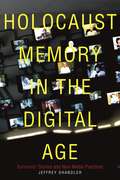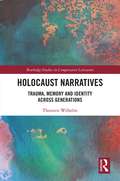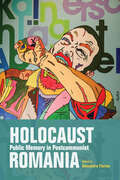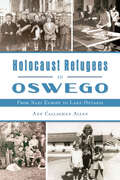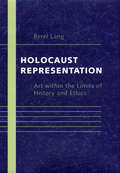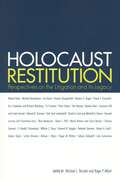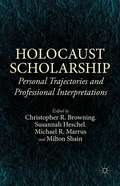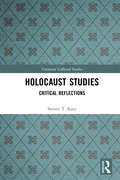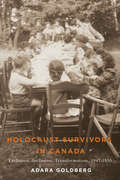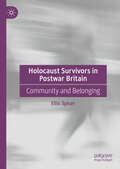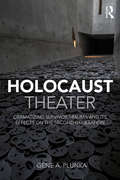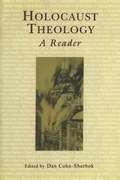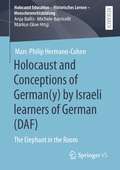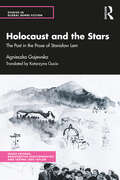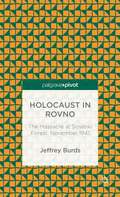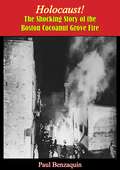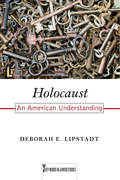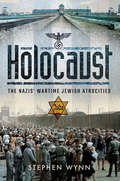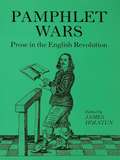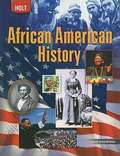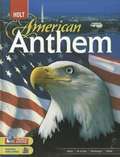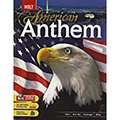- Table View
- List View
Holocaust Memory in the Digital Age: Survivors’ Stories and New Media Practices
by Jeffrey ShandlerHolocaust Memory in the Digital Age explores the nexus of new media and memory practices, raising questions about how advances in digital technologies continue to influence the nature of Holocaust memorialization. Through an in-depth study of the largest and most widely available collection of videotaped interviews with survivors and other witnesses to the Holocaust, the University of Southern California Shoah Foundation's Visual History Archive, Jeffrey Shandler weighs the possibilities and challenges brought about by digital forms of public memory. The Visual History Archive's holdings are extensive—over 100,000 hours of video, including interviews with over 50,000 individuals—and came about at a time of heightened anxiety about the imminent passing of the generation of Holocaust survivors and other eyewitnesses. Now, the Shoah Foundation's investment in new digital media is instrumental to its commitment to remembering the Holocaust both as a subject of historical importance in its own right and as a paradigmatic moral exhortation against intolerance. Shandler not only considers the Archive as a whole, but also looks closely at individual survivors' stories, focusing on narrative, language, and spectacle to understand how Holocaust remembrance is mediated.
Holocaust Narratives: Trauma, Memory and Identity Across Generations (Routledge Studies in Comparative Literature)
by Thorston WilhelmHolocaust Narratives: Trauma, Memory and Identity Across Generations analyzes individual multi-generational frameworks of Holocaust trauma to answer one essential question: How do these narratives change to not only transmit the trauma of the Holocaust – and in the process add meaning to what is inherently an event that annihilates meaning – but also construct the trauma as a connector to a past that needs to be continued in the present? Meaningless or not, unspeakable or not, unknowable or not, the trauma, in all its impossibilities and intractabilities, spawns literary and scholarly engagement on a large scale. Narrative is the key connector that structures trauma for both individual and collective.
Holocaust Public Memory in Postcommunist Romania (Studies In Antisemitism Ser.)
by Florian AlexandruHow is the Holocaust remembered in Romania since the fall of communism? Alexandru Florian and an international group of contributors unveil how and why Romania, a place where large segments of the Jewish and Roma populations perished, still fails to address its recent past. These essays focus on the roles of government and public actors that choose to promote, construct, defend, or contest the memory of the Holocaust, as well as the tools—the press, the media, monuments, and commemorations—that create public memory. Coming from a variety of perspectives, these essays provide a compelling view of what memories exist, how they are sustained, how they can be distorted, and how public remembrance of the Holocaust can be encouraged in Romanian society today.
Holocaust Refugees in Oswego: From Nazi Europe to Lake Ontario (American Heritage)
by Ann Callaghan AllenAmerica's Only Shelter Established for Holocaust Refugees/ During the height of the second World War, at the order of President Roosevelt, Fort Ontario in Oswego, New York housed 982 refugees, rescued from the horrors of the Holocaust. The community of Oswego answered the call of service and opened its arms to the survivors. Oswegonian and WWII veteran Joseph Spereno's connection with refugee Jake Sylber helped launch his tailoring business that was a fixture in the city for more than 20 years. Then high school Principal Ralph Faust was among local educators who fought to allow the refugee children into Oswego schools, forging connections with those young people who went on to distinguished careers. Local Boy Scout leader Harold Clark created a troop for refugee children to share in the American experience of scouting.Author Ann Callaghan Allen presents the harrowing narrative of how Oswego gave shelter to hundreds of Holocaust survivors.
Holocaust Representation: Art within the Limits of History and Ethics
by Berel LangSince Theodor Adorno's attack on the writing of poetry "after Auschwitz," artists and theorists have faced the problem of reconciling the moral enormity of the Nazi genocide with the artist's search for creative freedom. In Holocaust Representation, Berel Lang addresses the relation between ethics and art in the context of contemporary discussions of the Holocaust. Are certain aesthetic means or genres "out of bounds" for the Holocaust? To what extent should artists be constrained by the "actuality" of history—and is the Holocaust unique in raising these problems of representation?The dynamics between artistic form and content generally hold even more intensely, Lang argues, when art's subject has the moral weight of an event like the Holocaust. As authors reach beyond the standard conventions for more adequate means of representation, Holocaust writings frequently display a blurring of genres. The same impulse manifests itself in repeated claims of historical as well as artistic authenticity. Informing Lang's discussion are the recent conflicts about the truth-status of Benjamin Wilkomirski's "memoir" Fragments and the comic fantasy of Roberto Benigni's film Life Is Beautiful. Lang views Holocaust representation as limited by a combination of ethical and historical constraints. As art that violates such constraints often lapses into sentimentality or melodrama, cliché or kitsch, this becomes all the more objectionable when its subject is moral enormity. At an extreme, all Holocaust representation must face the test of whether its referent would not be more authentically expressed by silence—that is, by the absence of representation.
Holocaust Restitution
by Roger P. Alford Michael BazylerThe Holocaust was not only the greatest murder in history; it was also the greatest theft. Historians estimate that the Nazis stole roughly $230 billion to $320 billion in assets (figured in today’s dollars), from the Jews of Europe. Since the revelations concerning the wartime activities of the Swiss banks first broke in the late 1990s, an ever-widening circle of complicity and wrongdoing against Jews and other victims has emerged in the course of lawsuits waged by American lawyers. These suits involved German corporations, French and Austrian banks, European insurance companies, and double thefts of art—first by the Nazis, and then by museums and private collectors refusing to give them up. All of these injustices have come to light thanks to the American legal system. Holocaust Justice is the first book to tell the complete story of the legal campaign, conducted mainly on American soil, to address these injustices. Michael Bazyler, a legal scholar specializing in human rights and international law, takes an in-depth look at the series of lawsuits that gave rise to a coherent campaign to right historical wrongs. Diplomacy, individual pleas for justice by Holocaust survivors and various Jewish organizations for the last fifty years, and even suits in foreign courts, had not worked. It was only with the intervention of the American courts that elderly Holocaust survivors and millions of other wartime victims throughout the world were awarded compensation, and equally important, acknowledgment of the crimes committed against them. The unique features of the American system of justice—which allowed it to handle claims that originated over fifty years ago and in another part of the world—made it the only forum in the world where Holocaust claims could be heard. Without the lawsuits brought by American lawyers, Bazyler asserts, the claims of the elderly survivors and their heirs would continue to be ignored. For the first time in history, European and even American corporations are now being forced to pay restitution for war crimes totaling billions of dollars to Holocaust survivors and other victims. Bazyler deftly tells the unfolding stories: the Swiss banks’ attempt to hide dormant bank accounts belonging to Holocaust survivors or heirs of those who perished in the war; German private companies that used slave laborers during World War II—including American subsidiaries in Germany; Italian, Swiss and German insurance companies that refused to pay on prewar policies; and the legal wrangle going on today in American courts over art looted by the Nazis in wartime Europe. He describes both the human and legal dramas involved in the struggle for restitution, bringing the often-forgotten voices of Holocaust survivors to the forefront. He also addresses the controversial legal and moral issues over Holocaust restitution and the ethical debates over the distribution of funds. With an eye to the future, Bazyler discusses the enduring legacy of Holocaust restitution litigation, which is already being used as a model for obtaining justice for historical wrongs on both the domestic and international stage.
Holocaust Restitution: Perspectives on the Litigation and Its Legacy
by Michael J. Bazyler Roger P. AlfordHolocaust Restitution is the first volume to present the Holocaust restitution movement directly from the viewpoints of the various parties involved in the campaigns and settlements. Now that the Holocaust restitution claims are closed, this work enjoys the benefits of hindsight to provide a definitive assessment of the movement.From lawyers and State Department officials to survivors and heads of key institutes involved in the negotiations, the volume brings together the central players in the Holocaust restitution movement, both pro and con. The volume examines the claims against European banks and against Germany and Austria relating to forced labor, insurance claims, and looted art claims. It considers their significance, their legacy, and the moral issues involved in seeking and receiving restitution.Contributors: Roland Bank, Michael Berenbaum, Lee Boyd, Thomas Buergenthal, Monica S. Dugot, Stuart E. Eizenstat, Eric Freedman and Richard Weisberg, Si Frumkin, Peter Hayes, Kai Henning, Roman Kent, Lawrence Kill and Linda Gerstel, Edward R. Korman, Otto Graf Lambsdorff, David A. Lash and Mitchell A. Kamin, Hannah Lessing and Fiorentina Azizi, Burt Neuborne, Owen C. Pell, Morris Ratner and Caryn Becker, Shimon Samuels, E. Randol Schoenberg, William Z. Slany, Howard N. Spiegler, Deborah Sturman, Robert A. Swift, Gideon Taylor, Lothar Ulsamer, Melvyn I. Weiss, Roger M. Witten, Sidney Zabludoff, and Arie Zuckerman.
Holocaust Scholarship: Personal Trajectories and Professional Interpretations
by Christopher Browning Susannah Heschel Milton Shain Michael MarrusLeading international Holocaust scholars reflect upon their personal experiences and professional trajectories over many decades of immersion in the field. Changes are examined within the context of individual odysseys, including shifting cultural milieus and robust academic conflicts.
Holocaust Studies: Critical Reflections (Variorum Collected Studies)
by Steven T. KatzThe great majority of Holocaust scholarship concentrates heavily, if not almost completely, on the Final Solution from the German side. The distinctive feature of this book, both individually and as a collection, is its concentration on the Holocaust from a Judeo-centric point of view. The present essays make a unique contribution by exploring issues such as: the effect of events specifically on Jewish women and children; the character of the Nazi policy of slave labor in as much as this essential program resulted in different treatment with regard to Jews as compared to other workers; how the destruction of European Jewry has been responded to by Jewish thinkers; and how Jewish values, such as the well-known principle that "all Jews are responsible for each other," were exemplified and lived out during the war. The collection also includes an essay on Elie Wiesel, and another that explores the much discussed, very controversial issue of Jewish resistance, as well as several essays on philosophical and comparative issues raised by the Shoah.
Holocaust Survivors in Canada: Exclusion, Inclusion, Transformation, 1947-1955
by Adara GoldbergIn the decade after the Second World War, 35,000 Jewish survivors of Nazi persecution and their dependants arrived in Canada. This was a watershed moment in Canadian Jewish history. The unprecedented scale of the relief effort required for the survivors, compounded by their unique social, psychological, and emotional needs challenged both the established Jewish community and resettlement agents alike. Adara Goldberg’s Holocaust Survivors in Canada highlights the immigration, resettlement, and integration experience from the perspective of Holocaust survivors and those charged with helping them. The book explores the relationships between the survivors, Jewish social service organizations, and local Jewish communities; it considers how those relationships—strained by disparities in experience, language, culture, and worldview—both facilitated and impeded the ability of survivors to adapt to a new country. Researched in basement archives and as well as at Holocaust survivors’ kitchen tables, Holocaust Survivors in Canada represents the first comprehensive analysis of the resettlement, integration, and acculturation experience of survivors in early postwar Canada. Goldberg reveals the challenges in responding to, and recovering from, genocide—not through the lens of lawmakers, but from the perspective of “new Canadians” themselves.
Holocaust Survivors in Postwar Britain: Community and Belonging
by Ellis SpicerThis book pays particular attention to the experiences of younger child survivors of the Holocaust, considering how they kept in touch with one another, and how they integrated into larger cohorts of survivors settling in postwar Britain. Digging deeper than ever before into their postwar circumstances exposes the process of rebuilding shattered lives and the evolution of community relations, including both the beneficial and re-traumatising effects engendered by these networks. Newly conducted interviews put the experiences of younger survivors centre stage. These individuals did not receive much attention or status as survivors until the 1990s, and whilst they represent the most active cohort of survivor speakers in the UK, their narratives and community relations have been markedly absent from academic study.
Holocaust Theater: Dramatizing Survivor Trauma and its Effects on the Second Generation (Cambridge Studies In Modern Theatre Ser.)
by Gene A. PlunkaFacts about the Holocaust are one way of learning about its devastating impact, but presenting personal manifestations of trauma can be more effective than citing statistics. Holocaust Theater addresses a selection of contemporary plays about the Holocaust, examining how collective and individual trauma is represented in dramatic texts, and considering the ways in which spectators might be swayed viscerally, intellectually, and emotionally by witnessing such representations onstage. Drawing on interviews with a number of the playwrights alongside psychoanalytic studies of survivor trauma, this volume seeks to foster understanding of the traumatic effects of the Holocaust on subsequent generations. Holocaust Theater offers a vital account of theater’s capacity to represent the effects of Holocaust trauma.
Holocaust Theology: A Reader
by Dan Cohn-SherbokWhere was God during the Holocaust? And where has God been since? How has our religious belief been changed by the Shoah? For more than half a century, these questions have haunted both Jewish and Christian theologians. Holocaust Theology provides a panoramic survey of the writings of more than one hundred leading Jewish and Christian thinkers on these profound theological problems. Beginning with a general introduction to Holocaust theology and the religious challenge of the Holocaust, this sweeping collection brings together in one volume a coherent overview of the key theologies which have shaped responses to the Holocaust over the last several decades, including those addressing perplexing questions regarding Christian responsibility and culpability during the Nazi era. Each reading is preceded by a brief introduction. The volume will be invaluable to Rabbis and the clergy, students, scholars of the Holocaust and of religion.
Holocaust and Conceptions of German: The Elephant in the Room (Holocaust Education – Historisches Lernen – Menschenrechtsbildung)
by Marc-Philip Hermann-CohenThe Holocaust is inseparable from the Israeli identities even seven decades following the atrocities during World War II, Israeli daily life is shaped by the horrible crimes committed by the Nazis. This book conceptualizes the intricacies of the Israeli identity in relation to learning German as a foreign language (GFL) in Israel throughout the course of history and the changing conception of Germany. This book includes an analysis of a selection of twenty-five GFL language books which reflect the stigmatization and tabooization of the Holocaust and also the qualitative analysis of a subject pool of 105 learners of GFL. The author finds that identities are co-constituted by four individualized Thought Styles, a concept borrowed from Ludwik Fleck. Thought Styles capture the individual perspective of the language learner’s view of Germany and are categorized in this thesis as German Engineering, Cold Germany, Neo-Nazi Germany, and The Other Germany. The research draws from discourse theory, critical psychology, and the oft-overlooked classical theory of Ludwik Fleck. Although the relationship between Germany and Israel has been amicable for the last six decades, the choice for Israelis to learn the language that was used by a nation that once attempted to eradicate the Jewish people is emotive and infinitely complex.
Holocaust and the Stars: The Past in the Prose of Stanisław Lem (Studies in Global Genre Fiction)
by Agnieszka GajewskaThis book is a groundbreaking study of one of the greatest science fiction writers, the Polish master Stanisław Lem. It offers a new direction in research on his oeuvre and corrects several errors commonly appearing in his biographies. The author painstakingly recreates the context of Lem’s early life and his traumatic experiences during the Second World War due to his Jewish background, and then traces these through original and brilliant readings of his fiction and non-fiction. She considers language, worldbuilding, themes, motifs and characterization as well as many buried allusions to the Holocaust in Lem’s published and archival work, and uses these fragments to capture a different side of Lem than previously known. The book discusses various issues concerning the writer’s life, such as his upbringing in a Jewish, Zionist-minded family, the extensive relations between the Lem family and the elite of Lviv at that time, details of the Lem family killed during the German occupation and attempts to reconstruct what happened to Lem’s parents and to the writer himself after escaping the ghetto. Part of the Studies in Global Genre Fiction series, this English translation of the Polish original, which has already been considered a milestone in Lem studies, offers a fresh perspective on the writer and his work. It will be an important intervention for scholars and researchers of Jewish studies, Holocaust literature, science fiction studies, English literature, world war studies, minority studies, popular culture, history and cultural studies.
Holocaust in Rovno: The Massacre at Sosenki Forest, November 1941
by Jeffrey BurdsIn November 1941, near the city of Rovno, Ukraine, German death squads murdered over 23,000 Jews in what has been described as the second Babi Yar. This meticulous and methodologically innovative study reconstructs the events at Rovno, and in the process exemplifies efforts to form a genuinely transnational history of the Holocaust.
Holocaust!: The Shocking Story of the Boston Cocoanut Grove Fire
by Paul BenzaquinFirst published in November 1959, this is the bestselling account of the fire at The Cocoanut Grove, a premier nightclub during the post-Prohibition 1930s and 1940s in Boston, Massachusetts, on the night of November 28, 1942.It was the scene of the deadliest nightclub fire in history, killing 492 people and injuring hundreds more. The scale of the tragedy shocked the nation and briefly replaced the events of World War II in newspaper headlines. It led to a reform of safety standards and codes across the U.S., and to major changes in the treatment and rehabilitation of burn victims internationally.Written by radio broadcaster and Boston Globe journalist, Paul Benzaquin, this book is widely regarded as one of the most harrowing tales in the annals of disaster: a story of panic and desperation, of chaos and utter fear, it is also a story of almost incredible courage and ingenuity in the midst of despair.What gives this story lasting value is its emphasis on the aftermath of the fire: the medical innovations wrought by hospital workers in their attempt to save lives; the change in safety regulations brought about by the official enquiry in to the causes of the fire.Paul Benzaquin has scrupulously sifted facts from fancy and with powerful dramatic force molded these and other important elements into a stunning narrative, making Holocaust! a powerful book.Unmissable reading.Contains a detailed layout plan of The Cocanut Grove illustrated with over 20 black-and-white photographs.
Holocaust: An American Understanding
by Deborah E. LipstadtImmediately after World War II, there was little discussion of the Holocaust, but today the word has grown into a potent political and moral symbol, recognized by all. In Holocaust: An American Understanding, renowned historian Deborah E. Lipstadt explores this striking evolution in Holocaust consciousness, revealing how a broad array of Americans--from students in middle schools to presidents of the United States--tried to make sense of this inexplicable disaster, and how they came to use the Holocaust as a lens to interpret their own history. Lipstadt weaves a powerful narrative that touches on events as varied as the civil rights movement, Vietnam, Stonewall, and the women's movement, as well as controversies over Bitburg, the Rwandan genocide, and the bombing of Kosovo. Drawing upon extensive research on politics, popular culture, student protests, religious debates and various strains of Zionist ideologies, Lipstadt traces how the Holocaust became integral to the fabric of American life. Even popular culture, including such films as Dr. Strangelove and such books as John Hershey's The Wall, was influenced by and in turn influenced thinking about the Holocaust. Equally important, the book shows how Americans used the Holocaust to make sense of what was happening in the United States. Many Americans saw the civil rights movement in light of Nazi oppression, for example, while others feared that American soldiers in Vietnam were destroying a people identified by the government as the enemy. Lipstadt demonstrates that the Holocaust became not just a tragedy to be understood but also a tool for interpreting America and its place in the world. Ultimately Holocaust: An American Understanding tells us as much about America in the years since the end of World War II as it does about the Holocaust itself.
Holocaust: The Nazis' Wartime Jewish Atrocities
by Stephen Wynn“Trace[s] the developing Holocaust from the Odessa Massacre . . . a very good point to start into understanding this terrible genocide.” —FiretrenchIn Holocaust, Stephen Wynn looks at the build up to the Second World War, from the time of Hitler’s appointment as Chancellor of Germany in January 1933, as the Nazi Party rose to power in a country that was still struggling to recover politically, socially and financially from the aftermath of the First World War, while at the same time, through the enactment of a number of laws, making life extremely difficult for German Jews. Some saw the dangers ahead for Jews in Germany and did their best to get out, some managed to do so, but millions more did not. The book then moves on to look at a wartime Nazi Germany and how the dislike of the Jews had gone from painting the star of David on shop windows, to their mass murder in the thousands of concentration camps that were scattered throughout Germany. As well as the camps, it looks at some of those who were culpable for the atrocities that were carried out in the name of Nazism. Not all those who were murdered lost their lives in concentration camps. Some were killed in massacres, some in ghettos and some by the feared and hated Einsatzgruppen.“Historical studies like Holocaust: The Nazis’ Wartime Jewish Atrocities are increasingly necessary to remind present and future generations of what can happen when the forces of bigotry and racially motivated hatred goes unchecked in even the most civilized of nations.” —Midwest Book Review
Holstun Pamphlet Wars: Prose in the English Revolution
by James HolstunThe English Revolution of 1642-60 produced an explosion of stylistically and ideologically diverse pamphlet literature. The essays collected here focus on the prose of this new revolutionary era, and the new public sphere it helped to create. They cover a wide range of topics including the Royalist attack on the Sectarian Babel and the street theatre of the Ranters.
Holt American Anthem
by Edward L. Ayers Robert D. Schulzinger Jesús F. de la TejaNIMAC-sourced textbook
Holt American Anthem New York
by Edward L. Ayers Robert D. Schulzinger Jesús F. de la Teja Deborah Gray WhiteHolt American Anthem New York
